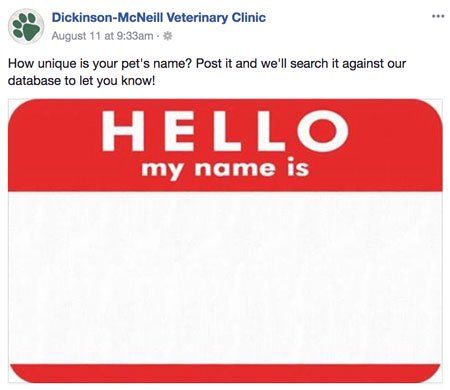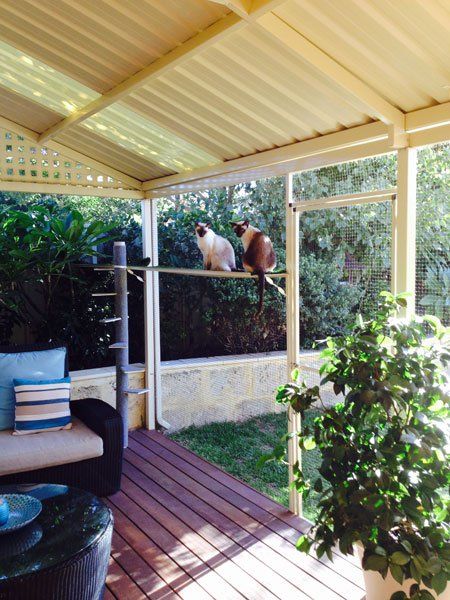The Top 10 team tips of 2017
From clinical tips to time savers and marketing hacks, start your year right with our most popular veterinary tips of the year.
10. How to win on social media
Here's a fun social media engagement idea for your veterinary practice to use. Ask clients, 'How unique is your pet's name?' They loved it at Dickinson-McNeill Veterinary Clinic in Chesterfield, New Jersey. They posted this: "How unique is your pet's name? Post it and we'll search it against our database to let you know."
Brent Dickinson, practice manager at Dickinson-McNeill Veterinary Clinic, explains how it works:
When someone comments with their pet's name and species, myself or a team member look it up in our client database and serve up its popularity-or uniqueness. We got a huge response. Sixty-seven comments at last count.

9. Advice to cut the clinic cord when you clock out
Are you worried about a hospitalized patient? Is a team conflict preying on your mind? Or have you lost the ability to take care of yourself? If you struggle to mentally distance yourself from your veterinary patients and team members-even when they're miles away and you're off the clock-read these tips and prepare to disengage.

shutterstock.com
8. A tip to boost your client service
The writing's on the wall-or, rather, the smartphone-that clients want to communicate with you in much different ways then they did 10 years ago. Now the ball is in your court to give them what they want.
But who has time to send texts, send and receive medical records, manage online appointments and send patient updates and cute pics to information-hungry pet owners? (Hint: It's a staffing issue. And this team member will quickly pay dividends when you up your level of client service.) Here's how one practice gets it done.

7. 1 easy trick to get clients to love you
Every client loves seeing their pet's photo, so why doesn't it show up on every written piece from your hospital?
Here's as complicated as it needs to be, if you have any trouble directly saving to your software:
1. Take a pet profile picture.
2. Upload it to Facebook (but keep it private) from the smartphone, tablet or laptop-whatever you used to take it.
3. Save it back to your practice software in the patient's record.
4. Put it on everything the client gets.
Read how one practice integrates the photos into their software here.

shutterstock.com
6. 8 tips for job seekers
Check out these resume and interview tips from a hiring manager, then write your next great resume or nail that next job interview at a veterinary practice.

5. Exam room enrichment tips
Are you ready to take the scary out of a pet's exam? Consider this approach for a more enriching experience.
Prep the exam room for patient arrival. This includes soft lamp lighting (spot lighting from phone when needed), calming music, white noise, a thick mat for floor seating if preferred, a variety of treats, supplies for the exam and diagnostics at the ready. Remember, when people enter and exit rooms, this is arousing to the pet and can increase stress. It's also a good idea to have a laptop on hand for scheduling rechecks. This minimizes the pet's time in the lobby.
Position the animal according to the patient's preference for exams, diagnostics and treatment to minimize the pet's stress. Fear and stress activate flight, fight, freeze or fidget responses. It's important to maintain the perception of flight to minimize escalation to fight. (Image courtesy of Medvet Medical & Cancer Center.)

Read more exam room enrichment tips here.
4. 9 tips for uneventful anesthesia and recovery
Uneventful. Routine. Boring. Not how you want to define your life, but definitely how you want to define your anesthetic cases. In these cases, uneventful is actually the ultimate goal! Before you or your team rev up for your next full surgery day, here are nine tips from a recent Fetch dvm360 Launchpad Learning session, “Anesthesia basics and beyond: Things you learned in school but have forgotten.” In this session, the original Anesthesia Nerd, Tasha McNerney, BS, CVT, VTS (anesthesia and analgesia), discussed how to make your anesthesia as smooth and uneventful as possible.
Tip 1. Know the critical period for brachycephalics
McNerney says brachycephalics are most likely to have a problem with hypoxia during induction or postoperatively. Monitor these guys closely at all times but especially during induction and until they are fully recovered.

3. Create an enriched cat space
Cats tend to seek height and hiding when they feel stressed and afraid. Here's how to create a safe cage space for healing:
• Use a towel sprayed with Feliway pheromones to create a partial visual barrier for the door. This allows eating and elimination in privacy.
• Natural or low light is best.
• The hide box allows a choice.
• The fleece on top provides a higher perch.
• Fleece flooring provides warmth and sound dampening of a steel cage.
• Small water bowls maximize space and a flat food dish to prevent whisker stimulation from small bowls.
• The puzzle feeder with kibble inside offers engagement.

Image courtesy of Avery Animal Hospital
Read more hospital enrichment tips here.
2. Build your own “catio”
It's a known fact that the average life span of a cat with free access to roam outdoors is significantly shorter than those kept indoors. Car accidents, access to poisons, cat fights, dog attacks, snake bites and infectious diseases are just some of the deadly dangers that a free-roaming cat has to try and avoid.
But keeping cats exclusively indoors to protect them from these dangers also comes with risks, and cats confined strictly to the indoors have a much higher incidence of stress-related diseases such as feline idiopathic cystitis, upper respiratory infections and gastrointestinal diseases such as inflammatory bowel disease. There's also a much higher incidence of behavior disorders, such as inappropriate elimination, which, sadly, is the most common reason pet owners surrender a cat to a shelter.
The good news: An enclosed “catio”-an outdoor patio for cats that safely confines the cat to the owner's property-allows cats to have the best of both worlds.

Photo courtesy of Martine van Boeijen, BSc, BVMS, MANZCVSc (Medicine of Cats)
Check out the full instructions to build a DIY outdoor patio for cats.
1. Squirt a little ‘magic' in that hissing cat's mouth
Veterinary anesthesia and analgesia expert Tasha McNerney makes a case for kitty magic and describes how to deliver it to particularly peevish cats.
“Kitty magic, a cocktail of dexmedetomidine, ketamine and butorphanol, is something that people are using in practice a lot. But I think it's important to note that kitty magic sometimes gets a bad rap,” says Fetch dvm360 conference educator Tasha McNerney BS, CVT, CVPP, VTS (anesthesia and analgesia). “While it's certainly not as nuanced as titrating a specific IV anesthesia, for fractious cats or for cats that are scared out of their minds, the drug combination in kitty magic can provide good analgesia.”

Got your own hot tip to share? Send it to us at firstline@ubm.com. We'll pay for every tip we publish.